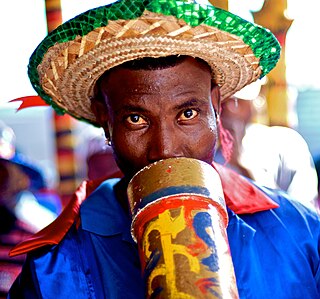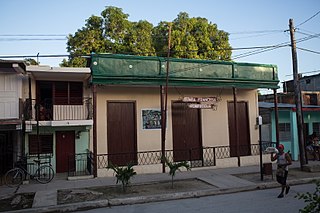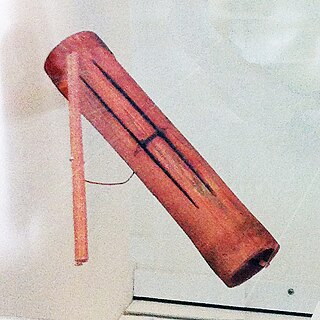Related Research Articles
The music of Haiti combines a wide range of influences drawn from the diverse population that has settled on this Caribbean island. It often has hints of French, African rhythms, Spanish elements and others who have inhabited the island of Hispaniola and minor native Taino influences. Styles of music unique to the nation of Haiti include music derived from rara parading music, twoubadou ballads, mini-jazz rock bands, rasin movement, hip hop Creòle, the wildly popular compas, and méringue as its basic rhythm. Haitian music is influenced mostly by European colonial ties and African migration. In the case of European colonization, musical influence has derived primarily from the French.
The music of Martinique has a heritage which is intertwined with that of its sister island, Guadeloupe. Despite their small size, the islands have created a large popular music industry, which gained in international renown after the success of zouk music in the later 20th century. Zouk's popularity was particularly intense in France, where the genre became an important symbol of identity for Martinique and Guadeloupe. Zouk's origins are in the folk music of Martinique and Guadeloupe, especially Martinican chouval bwa, and Guadeloupan gwo ka. There's also notable influence of the pan-Caribbean calypso tradition and Haitian kompa.
Zouk is a musical movement and dance pioneered by the French Antillean band Kassav' in the early 1980s. It was originally characterized by a fast tempo, a percussion-driven rhythm, and a loud horn section. Musicians from Martinique and Guadeloupe eventually added MIDI instrumentation to their compas style, which developed into a genre called zouk-love. Zouk-love is effectively the French Lesser Antilles' compas, and it gradually became indistinguishable from compas.
The culture of Haiti is a creolized blend of African, European and Taino elements due to the French colonization of Amerindian land, in conjunction with the large diverse enslaved African population who had later freed themselves by a successful revolt. These attributions have largely influenced the art, cuisine, literature, music, religion as well as the languages of Haiti.

Compas, also known as konpa or kompa, is a modern méringue dance music genre of Haiti. The genre was popularized by Nemours Jean-Baptiste following the creation of Ensemble Aux Callebasses in 1955, which became Ensemble Nemours Jean-Baptiste in 1957. The frequent tours of the many Haitian bands have cemented the style in all the Caribbean. Therefore, compas is the main music of several countries such as Dominica and the French Antilles. Whether it is called zouk, where French Antilles artists of Martinique and Guadeloupe have taken it, or konpa in places where Haitian artists have toured, this méringue style is influential in part of the Caribbean, Portugal, Cape Verde, France, part of Canada, and South and North America.
Afro-Caribbean music is a broad term for music styles originating in the Caribbean from the African diaspora. These types of music usually have West African/Central African influence because of the presence and history of African people and their descendants living in the Caribbean, as a result of the trans-Atlantic slave trade. These distinctive musical art forms came about from the cultural mingling of African, Indigenous, and European inhabitants. Characteristically, Afro-Caribbean music incorporates components, instruments and influences from a variety of African cultures, as well as Indigenous and European cultures.

Danza is a musical genre that originated in Ponce, a city in southern Puerto Rico. It is a popular turn-of-the-twentieth-century ballroom dance genre slightly similar to the waltz. Both the danza and its cousin the contradanza are sequence dances, performed to a pattern, usually of squares, to music that was instrumental. Neither the contradanza nor the danza were sung genres; this is a contrast to, for example, the habanera, which was a sung genre. There is some dispute as to whether the danza was in any sense a different dance from the contradanza, or whether it was just a simplification of the name. Through the first part of the 19th century the dance and its music became steadily more creolized. The music and the dance is creolized because composers were consciously trying to integrate African and European ideas because many of the people themselves were creoles, that is, born in the Caribbean; accepting their islands as their true and only homeland.
Cadence rampa, or simply kadans, is a dance music and modern méringue popularized in the Caribbean by the virtuoso Haitian sax player Webert Sicot in the early 1960s. Cadence rampa was one of the sources of cadence-lypso. Cadence and compas are two names for the same Haitian modern méringue.

Rara is a form of festival music that originated in Haiti that is used for street processions, typically during Easter Week. The music centers on a set of cylindrical bamboo trumpets called vaksin, but also features drums, maracas, güiras or güiros, and metal bells, as well as alsos which are made from recycled metal, often coffee cans. The vaksin perform repeating patterns in hocket and often strike their instruments rhythmically with a stick while blowing into them. In the modern day, standard trumpets and saxophones may also be used. The genre though predominantly Afro-based has some Taino Amerindian elements to it such as the use of güiros and maracas.

Tumba francesa is a secular Afro-Cuban genre of dance, song, and drumming that emerged in Oriente, Cuba. It was introduced by slaves from the French colony of Saint-Domingue whose owners resettled in Cuba's eastern regions following the slave rebellion during the 1790s. The genre flourished in the late 19th century with the establishment of sociedades de tumba francesa, of which only three survive.
Méringue, also called méringue lente or méringue de salon, is a dance music and national symbol in Haiti. It is a string-based style played on the guitar, horn section, piano, and other string instruments unlike the accordion-based merengue, and is generally sung in Haitian Creole and French, as well as in English and Spanish.
Rap Kreyòl started in Haiti in the early ‘80s by the Late Great Master Dji, who witnessed how American Hip Hop gave birth to French Hip Hop while living in France. Hence, he moved back to Haiti and started the Hip Hop movement that took Haiti by storm. Consequently, many of those kids which Hip Hop spoke to in their special language for the first time continue to rap in Haitian Creole even after being in the United States the most part of their lives. Artists like Oz'mosis and Bennchoumy still rap in Haitian Creole still today.

The catá or guagua is a Cuban percussion instrument which originated in the eastern region of the island. It is classified as a directly struck idiophone, traditionally made out of a hollowed tree trunk, which the player hits with wooden sticks or mallets. The resulting sound is dry and penetrating, similar to that of the claves, although with a different pitch. Of Congolese origin, it is an essential instrument in tumba francesa, yuka and some rumba ensembles.
Haitian rock, or rock kreyòl, started as rock n roll in Haiti in the early 1960s. It was played by rock bands called yeye bands. The name yeye derives from the Beatles lyrical verse, "yeah, yeah, yeah", which took off in the United States and was listened to by upper class Haitian families who had access to the radio. Young Haitians formed small electric guitar-based bands. These yeye rock bands were short-lived, as the addition of compas to their repertoires resulted in a sound was called mini-jazz, or mini-djaz in Haitian Creole.
Kontradans or the French-Haitian Contredanse, is creolized dance music formed in the 18th century in the French colony of Saint-Domingue (Haiti) that evolved from the English contra dance, or, which eventually spread throughout the Caribbean, Louisiana, Europe and the rest of the New World from the Creoles of Saint-Domingue.
Eddy François is a Haitian musician,
Tahona, alternatively spelled tajona due to its pronunciation or taona, is a secular style of Afro-Cuban music developed in the 19th century in Santiago de Cuba after the arrival of Haitian slaves following the Haitian Revolution. It is named after the ensembles and the drums played by them. It is considered one of the oldest styles within the rumba complex, and its performance became rare by the 20th century.
Auguste Linstant de Pradines, also known as August de Pradines, Ti Candio or Kandjo was an influential Haitian musician who largely created the archetype of the Haitian troubadour. Over nearly five decades, de Pradines composed love songs as well as songs of political and social commentary, traveling throughout Haiti to perform in clubs, at private parties, in theaters, and outdoor rallies. de Pradines had twelve children, including his daughter Emerante de Pradines Morse who also became a prominent Haitian musician, as did her son, Richard Auguste Morse, and another of Auguste de Pradines' grandsons, Michel Martelly, who also served as president of Haiti (2011-2016).
References
- 1 2 3 "Masters of Caribbean Music" (PDF). Retrieved 28 January 2014.
- 1 2 "Masters of Caribbean Music" (PDF). Retrieved 20 January 2014.
- 1 2 Manuel, Peter with Kenneth Bilby, Michael Largey (2006). Caribbean Currents: Caribbean Music from Rumba to Reggae. Temple University Press. p. 156. ISBN 9781592134649 . Retrieved 20 January 2014.
{{cite book}}: CS1 maint: multiple names: authors list (link) - ↑ James, C. L. R. (1963) [1938]. The Black Jacobins (2nd ed.). New York: Vintage Books. pp. 45, 55. OCLC 362702.
- 1 2 3 Manuel, Peter with Kenneth Bilby, Michael Largey (2006). Caribbean Currents: Caribbean Music from Rumba to Reggae. Temple University Press. p. 156. ISBN 9781592134649 . Retrieved 29 January 2014.
{{cite book}}: CS1 maint: multiple names: authors list (link) - ↑ Averill, Gage (1997). A day for the hunter, a day for the prey: Popular music and power in Haiti. Chicago, Ill.: University of Chicago Press. ISBN 9780226032931.